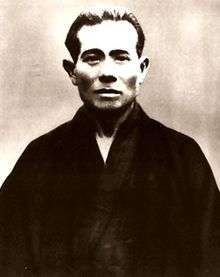Kanbun Uechi
| Kanbun Uechi 上地 完文 Uechi Kanbun | |
|---|---|
|
Kanbun Uechi | |
| Born |
May 5, 1877 Motobu, Okinawa, Ryukyu Kingdom |
| Died |
November 25, 1948 (aged 71) Ie, Okinawa, Empire of Japan |
| Native name | 上地 完文 Uechi Kanbun |
| Style | Pangainoon and Uechi Ryu |
| Teacher(s) | Shusshabu |
| Rank | Grandmaster 9th dan (maximum dan at that time) |
| Notable students | Kanei Uechi (son) |
Kanbun Uechi (上地 完文 Uechi Kanbun, May 5, 1877 – November 25, 1948) was the founder of Uechi-ryū, one of the primary karate styles of Okinawa.
Early life
Kanbun grew up in the mountain farming village of Izumi on the Motobu peninsula of Okinawa.[1] Uechi's family were farmers of daikon radishes. [2] In his youth, Uechi studied bōjutsu with Motobu experts. [3]
Time in China
Japan began a program of universal male conscription in Okinawa in the late 1800s. In 1897 at the age of 19, Kanbun fled to Fuzhou in Fukien Province, China both to escape Japanese military conscription and to fulfill his dreams of studying martial arts with Chinese masters.
Upon arrival in China, Uechi initially took up the study of Kojo Ryū, but dojo management mocked him for a speech impediment and the offended Uechi sought training elsewhere.[4]
Uechi next took up the study of herbalism and a Kung Fu system called "Pangai-noon" (or Pangainun), under a Chinese master named Shushiwa. Uechi received a certificate of mastery in 1904, and he later opened his own dojo in Nansoye, China.
Return to Okinawa
After returning to Okinawa in February 1910, Uechi moved to Wakayama City, in the Wakayama Prefecture of mainland Japan, where in 1925, he married as well as established the Institute of "Pangainun-ryu (half-hard and soft) Todi-jutsu", and began the process of launching his own dojo. Uechi continued to teach in Wakayama until 1948.[5]
The style he taught was renamed in 1940 to "Uechi-Ryū" Karate in his honor, and is one of the four major styles of Okinawan Karate. It was greatly systematized by Uechi's son, Kanei. Uechi-Ryū has students and dojos around the world, and it is particularly popular in the Northeastern United States (along with one of its variants, Shohei-ryu).
Family
Kanbun Uechi had four children. His oldest son, Kanei, continued his father's work in the martial arts. He had another son, Kansai, and two daughters, Tsuru (named after her grandmother) and Kamai.
References
- ↑ Mark Bishop, Okinawan Karate, Tuttle: 1999, p. 38
- ↑ Allan Dollar, Secrets of Uechi Ryu and the Mysteries of Okinawa, Cherokee Publishing: 1996, p. 54.
- ↑ Allan Dollar, Secrets of Uechi Ryu and the Mysteries of Okinawa, Cherokee Publishing: 1996, p. 55.
- ↑ Mark Bishop, Okinawan Karate, Tuttle: 1999, p. 39
- ↑ Mattson, George E., Uechiryu Karate Do (Classical Chinese Okinawan Self Defense), Peabody: 1997, pp. 10-12.
